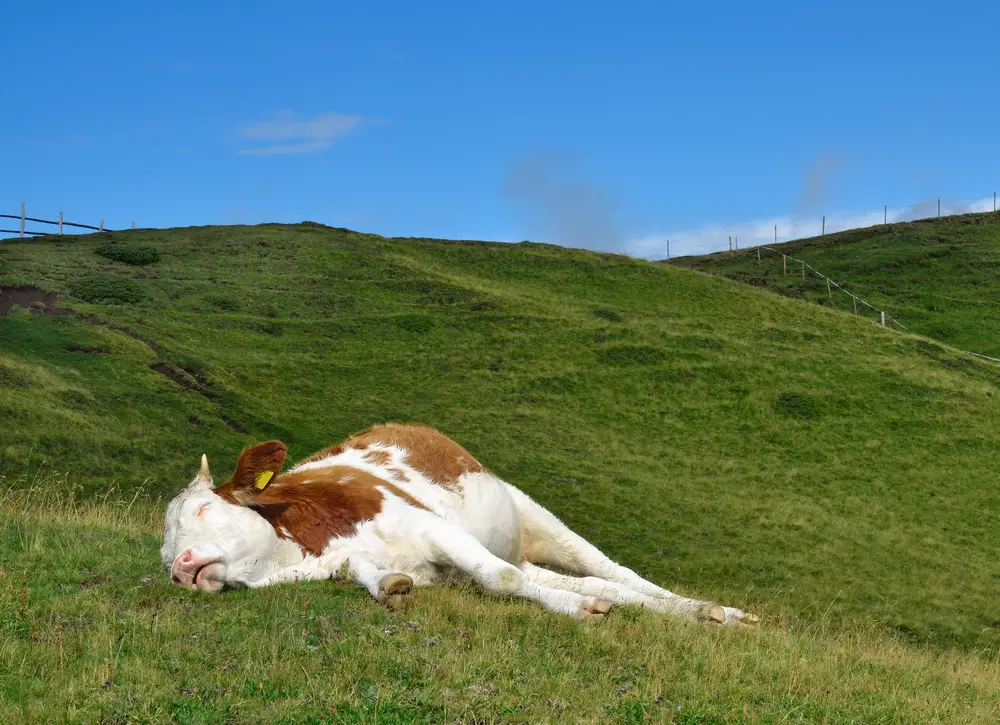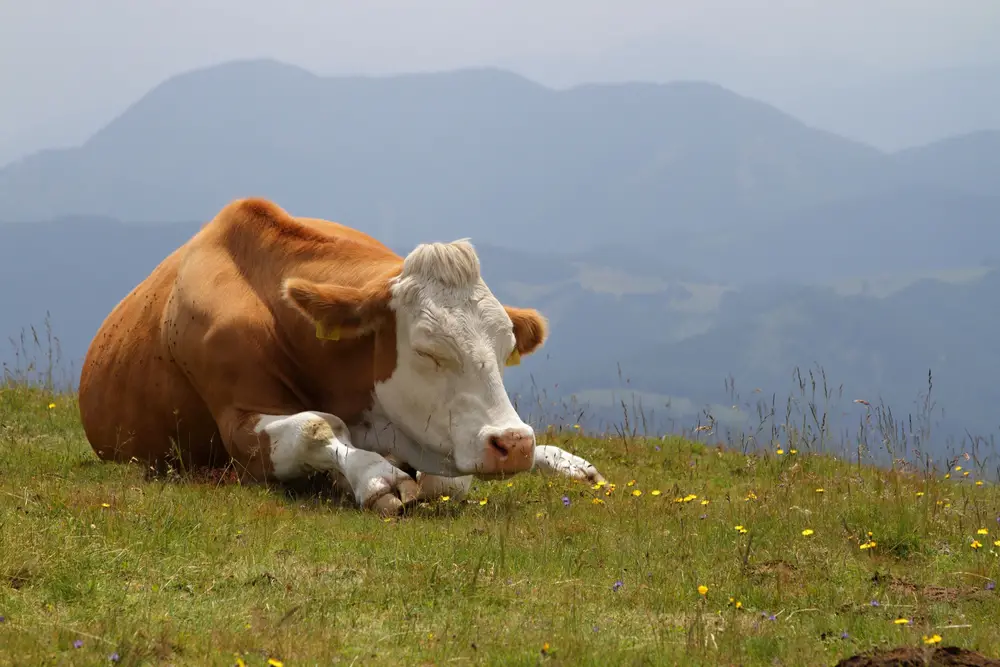Downer Cow Syndrome is a cow's inability to rise and stand for more than 24 hours, often due to trauma, metabolic problems, and toxic diseases. Other names include Bovine Secondary Recumbency or Cow With Down Syndrome, but has nothing to do with the human disease.
Treatment is guided by finding the initial cause and seeking immediate care.
Table of Contents
Downer Cow Explained
Recumbency is an inability to rise from the ground. A recumbent cow is unable to stand for an obvious reason or sometimes no apparent reason. When the cow has been recumbent for a prolonged period, it is referred to as a downer cow.
Lateral recumbency is when the cow lies flat on its side with its head on the ground. Sternal recumbency is when the cow is lying upright while resting on its breastbone with its head up.


Recumbency can occur on periparturient dairy cows that may have suffered damage to the nerves in the pelvic area or that have a metabolic imbalance. Prolonged cow recumbency results in pressure-induced death of muscle tissue affecting the hind legs.
An alert downer cow will often eat, drink, and pass urine and feces while still in sternal recumbency while a non-alert down cow will show signs of depression and illness. Downer cows are categorized either into non-ambulatory progressive or non-progressive with neurological conditions.
Diagnosis by a veterinary officer is essential to bring out nerve paralysis, broken bones, milk fever, or other clinical disorders that need immediate treatment.
Common Causes of Downer Cow
Metabolic Disorders
Various metabolic conditions can lead to a down cow. They include:
- Hypocalcemia (Milk Fever Or Parturient Paresis). Hypocalcemia is a disorder characterized by abnormally low levels of calcium in the cow’s blood. It occurs mostly three days after calving when the cow’s production of milk has strained its calcium stores.
- Hypomagnesemia (Lactation Tetany). Hypomagnesemia occurs when the cow’s body does not have efficient homeostatic mechanisms for steady maintenance of magnesium concentration in the blood. This is worsened by a short period of starvation, usually 24-48 hours.
- Nutritional Acidosis. Acidosis occurs when cows are not properly transitioned onto sugar/starch feed. It also occurs when cows are fed on large amounts of highly-fermentable carbohydrate-rich feeds. This causes the pH levels of the rumen to fall below normal.
- Ketosis. Ketosis occurs when energy demands (for example high milk production) exceed energy intake. It is caused by the deficiency of glucose in blood tissues.
- Hypokalaemia. Hypokalaemia is described as low levels of potassium in the blood. Clinical signs include muscle weakness, depression, and muscle twitches.
- Fatty Liver Disease. Fatty liver occurs when a cow breaks down too much fat for the liver to process, resulting in a negative energy balance.
- Hypophosphatemia. Hypophosphatemia is a condition in which cows’ blood has low levels of phosphorus. Clinical signs include muscle weakness, seizures, respiratory failure, or coma.
Toxic Disorders
Various toxic disorders can lead to bovine recumbency. They include:
- Acute Mastitis. Acute mastitis is the inflammation of the udder tissues due to bacterial infections caused by microorganisms. It is characterized by swelling, hardness, and pain in the cow’s udder.
- Acute Peurperal Metritis. Metritis is the inflammation of both the endometrial and muscular layers of the uterus. It is caused by a bacterial infection in postpartum dairy cattle and is characterized by fetid vaginal discharge, fever, and general depression.
- Peritonitis. Peritonitis is the inflammation of the serous membrane that lines the peritoneal cavity. It is caused by infectious agents and is characterized by fever, anorexia, pain, and depression.
- Traumatic Reticuloperitonitis. Traumatic reticuloperitonitis is the inflammation of the reticulum wall due to perforation by a sharp object e.g. a nail or wire that may have been ingested by a cow.
- Abomasal Volvulus. Abomasal volvulus occurs when the abomasum is displaced into the right abdominal cavity.
Neurological Disorders
Damage to and functional loss of the sciatic nerve results in muscle weakness in downer cows. The sciatic nerve is damaged by direct compression against the caudal femur, swelling of the surrounding muscles, or both.
Recovery of a down cow mainly depends on the extent of damage to the sciatic nerve.
The severity of pressure damage to the muscles is determined by:
- Duration of compression
- Regional anatomical factors
- The surface on which the animal is kept
Traumatic Disorders
A downer cow may be suffering from traumatic conditions which include joint dislocations, laceration, fractures of long bones, and rupture of muscles and tendons.
Treatment Options To Get Your Cow Moving
A thorough physical examination should be carried out by a veterinary officer to establish the cause of recumbency.
Treatment depends on the diagnosis performed by the veterinary officer and can include:
- Calcium drench for hypocalcemic cows.
- Nursing care and pain management.
- Monitoring of the status of blood minerals and hydration.
- An alert and responsive cow can be stimulated to rise or hoisted daily to check if its ability to rise or bear its weight is progressive.
- A cow in lateral recumbency should be rolled into sternal recumbency to avoid stomach problems. Support should be placed underneath the cow to maintain its posture.
- Anti-inflammatory medication can be administered on the trauma-affected hindlimbs to reduce pain and discomfort, and minimize swelling of muscles.
- If the cow is outdoors, it should be protected from harsh weather conditions. A downer cow can be lifted by using a hip clamp and a breast strap on the forks for cow safety and comfort.
- A recumbent cow can be tilted in 6-8 hour intervals from one side to the other to limit incidences of secondary pressure that can cause muscle and nerve damage.
- Wet manure with 10 inches of dry straw spread over it can be used to bed the area around and underneath the cow. This will provide better footing for the animal.
Ultimately, a downer cow can recover as long as it looks bright, occasionally struggles to rise, and continues to eat and drink.
